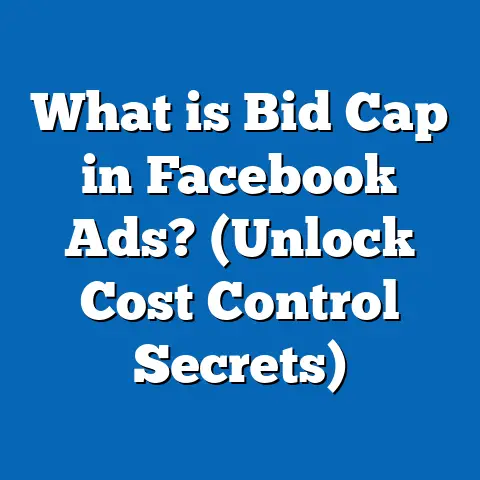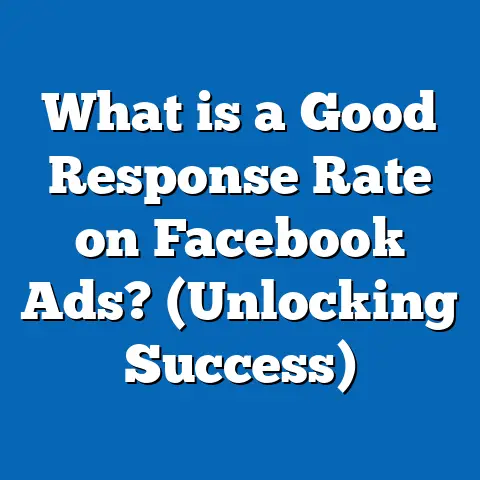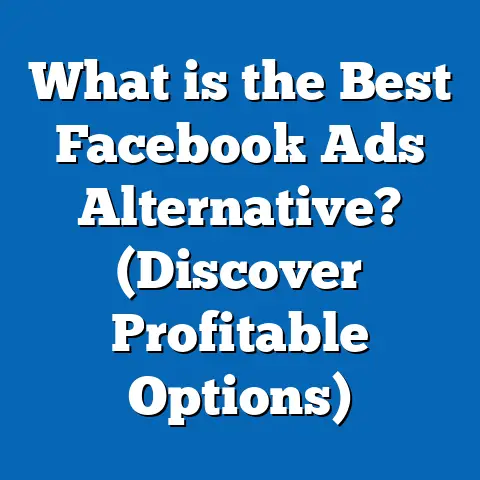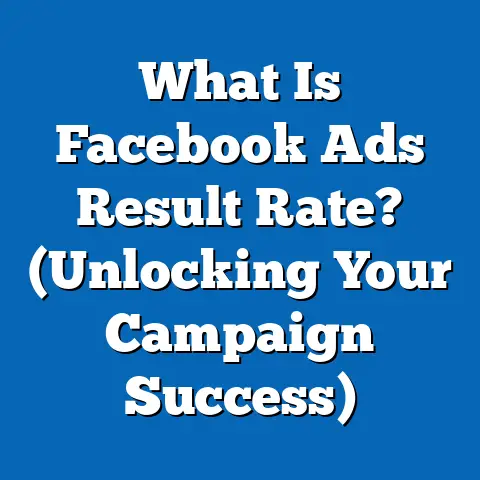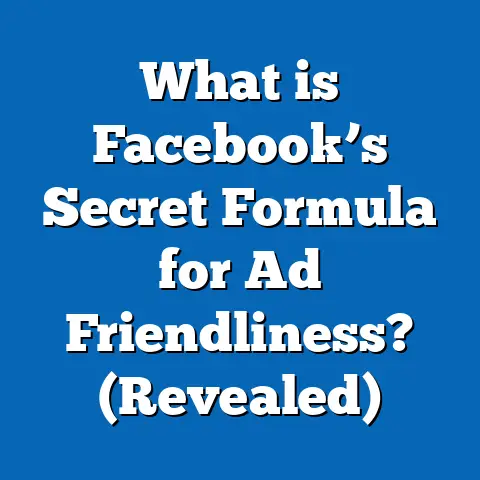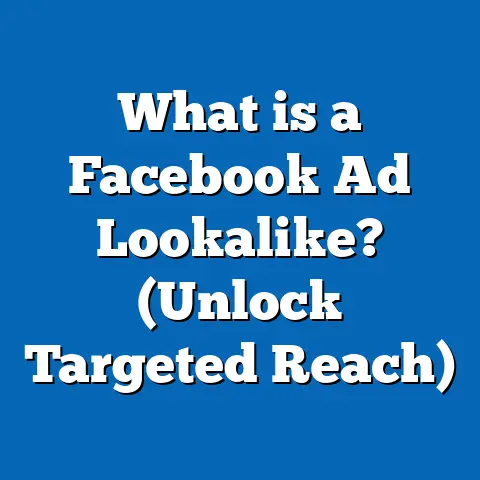What is Brand Awareness in Facebook Ads? (Unlocking Success)
What is Brand Awareness in Facebook Ads? (Unlocking Success)
Introduction: The Power of First Impressions and Brand Memory
Think back to the last time you discovered a new product or service online. Maybe it was a catchy video ad on your Facebook feed, a vibrant image that stopped you mid-scroll, or a relatable story shared by someone you follow. That moment of recognition or curiosity—when you first encountered the brand—is the essence of brand awareness. It’s the point where a brand starts to live in your mind.
In today’s hyper-connected digital world, consumers are bombarded with thousands of marketing messages every day. For a business, standing out in this crowded space is a major challenge. The key lies in creating memorable brand impressions that stick.
Facebook Ads offer a powerful toolset to build this essential brand awareness at scale. With billions of users and highly advanced targeting options, Facebook allows marketers to craft campaigns that not only reach massive audiences but also resonate deeply with the right people. But what exactly is brand awareness in Facebook advertising? How does it differ from other ad objectives? And why is it so critical for long-term business success?
This extensive guide will walk you through everything you need to know about brand awareness on Facebook Ads—from fundamental concepts to advanced strategies, backed by data, case studies, and actionable tips.
Understanding Brand Awareness: The Foundation of Marketing Success
What Exactly is Brand Awareness?
Brand awareness refers to how familiar your target audience is with your brand—how easily they recognize your logo, name, tagline, products, or services. It reflects the degree to which consumers can recall or identify your brand under different conditions.
Awareness is the starting point of any marketing funnel. It doesn’t necessarily mean immediate purchases but lays the groundwork for consideration and loyalty down the line.
Brand awareness operates on two main levels:
- Brand Recognition: When consumers can identify your brand when they see it.
- Brand Recall: When consumers can remember your brand without visual cues.
Both are crucial for building trust and preference.
Why Brand Awareness is the Cornerstone of Marketing
You might wonder: if brand awareness doesn’t directly generate sales, why invest in it?
Here’s why:
- Trust and Credibility: People prefer buying from brands they recognize. According to Nielsen’s Global Trust in Advertising report (2023), 59% of consumers trust brands they are familiar with.
- Customer Loyalty: Familiar brands tend to have better retention rates.
- Competitive Differentiation: In saturated markets, strong brand awareness sets you apart.
- Influences Purchase Decisions: Studies show that 71% of consumers buy from brands they recognize (HubSpot).
- Enables Future Campaigns: Brand-aware audiences respond better to retargeting and conversion campaigns.
Brand Awareness vs. Other Marketing Objectives
| Objective | Focus | Outcome | Typical Metrics |
|---|---|---|---|
| Brand Awareness | Maximize recognition and recall | Increased familiarity | Reach, Ad Recall Lift |
| Traffic | Drive visits to website/app | More site visitors | Click-Through Rate (CTR) |
| Engagement | Boost interactions (likes/comments/shares) | Higher social interaction | Engagement rate |
| Conversions | Drive purchases or sign-ups | Sales or leads | Conversion rate, ROAS |
Brand awareness campaigns are generally top-of-funnel initiatives focusing on impressions and recall rather than immediate conversions.
The Role of Facebook Ads in Building Brand Awareness
Why Choose Facebook for Brand Awareness?
Facebook remains the dominant social media advertising platform globally. Here’s why marketers favor it for brand awareness:
- Massive Audience Size: Over 3 billion monthly active users (Statista 2024), representing diverse demographics worldwide.
- Sophisticated Targeting: Options include demographics (age, gender), location, interests, behaviors, life events, and Custom & Lookalike Audiences.
- Varied Ad Formats: Video ads, carousel ads, collection ads, stories ads—all designed to capture attention differently.
- Cost Efficiency: Average CPM (cost per 1,000 impressions) on Facebook is often lower than TV or print advertising.
- Measurable Results: Real-time performance insights and specialized metrics like Estimated Ad Recall Lift (EARL).
- Integration with Instagram: Extend campaigns seamlessly across Facebook and Instagram for broader reach.
Facebook’s Brand Awareness Campaign Objective Explained
Facebook offers a campaign objective explicitly designed for brand awareness. Unlike general reach campaigns that focus on showing ads to the maximum number of people, the Brand Awareness objective uses Facebook’s machine learning algorithms to deliver ads to users most likely to remember them.
Key features:
- Estimated Ad Recall Lift (EARL): This metric predicts how many people will remember seeing your ad within two days if asked.
- Optimized Delivery: Ads are shown based on likelihood of recall rather than just impressions.
- Frequency Management: Controls how often people see your ads to avoid fatigue.
This objective helps marketers maximize the impact of their ads by focusing on quality impressions over quantity.
Data-Backed Insights on Brand Awareness Campaigns
Data gives us concrete evidence about how effective brand awareness campaigns can be.
Key Statistics
- According to Facebook internal reports (2023), campaigns optimized for brand awareness achieved an average increase of 35% in ad recall compared to traditional reach campaigns.
- A Nielsen Brand Effect study found that ads with high recall scores led to a 23% increase in purchase intent.
- HubSpot’s consumer behavior survey shows that 71% of consumers prefer buying from brands they recognize.
- WordStream reports that video ads on Facebook generate 6 times more engagement than static images, significantly enhancing brand memory.
- eMarketer forecasts that by 2025, digital video ad spend on platforms like Facebook will exceed $80 billion globally, reflecting growing trust in video formats for awareness.
Case Study #1: Nike’s Inspirational Brand Awareness Campaign
Nike used Facebook Brand Awareness campaigns to target young athletes with video ads sharing motivational stories. The campaign results:
- Over 50 million impressions within two months
- 28% increase in Estimated Ad Recall Lift (EARL)
- 15% uplift in website visits directly linked to the campaign
Nike’s use of storytelling combined with precise targeting maximized emotional connection and memorability.
Case Study #2: A Local Coffee Shop’s Carousel Ad Strategy
A small coffee shop used carousel ads featuring different drinks and cozy scenes targeting local coffee lovers aged 18-35. After running the campaign for one month:
- Reach increased by 60%
- Foot traffic grew by 25%
- Social media followers increased by 35%
This example shows that even small businesses can build meaningful awareness using Facebook’s tools.
Breaking Down Facebook’s Brand Awareness Tools and Metrics
Key Metrics You Should Track Closely
| Metric | Description | Importance |
|---|---|---|
| Estimated Ad Recall Lift (EARL) | Number of people predicted to remember your ad within two days | Direct measure of brand impact |
| Reach | Unique number of people who saw your ad | Indicates breadth of exposure |
| Frequency | Average times an individual saw your ad | Helps manage ad fatigue |
| Engagement Rate | Ratio of likes, comments, shares per impression | Shows interest level |
| Click-Through Rate (CTR) | Percentage clicking on your ad | Indicates curiosity beyond awareness |
Tools & Features for Boosting Brand Awareness on Facebook
- Video Ads
Videos grab attention and convey messages faster than text or images. According to HubSpot, videos increase organic reach on Facebook by 135%. - Carousel Ads
Carousel ads allow multiple images/videos in one ad unit, showcasing different products or features for richer storytelling. - Stories Ads
Full-screen vertical format ideal for immersive experiences with high engagement rates. - Lookalike Audiences
Reach new users who resemble your best customers based on behavior or demographics. - Custom Audiences
Retarget website visitors or app users to build familiarity. - Instant Experience Ads
Interactive mobile landing pages that load quickly within Facebook.
Crafting Effective Brand Awareness Campaigns on Facebook: Step-by-Step Guide
Step 1: Define Your Audience Precisely
Use Facebook’s Audience Insights tool to identify demographics interested in your niche. Layer interests, behaviors, and life events for best results.
Example: A fitness apparel brand targets males aged 18-34 interested in running, gym workouts, and health blogs.
Step 2: Develop Clear, Memorable Messaging
Keep your message simple yet impactful. Use consistent brand colors and logos to aid recognition. Emotional appeals often work well—show how your brand improves lives or solves problems.
Step 3: Select the Right Ad Format
- Use video for storytelling or product demos.
- Carousel ads for showcasing multiple features.
- Stories ads for short bursts of engaging content.
Step 4: Optimize Campaign Settings Correctly
Choose “Brand Awareness” as the campaign objective. Set frequency caps between 2-3 impressions per person weekly to prevent ad fatigue while ensuring repeated exposure.
Step 5: Monitor Performance & Iterate
Track Estimated Ad Recall Lift along with engagement metrics regularly. Use A/B testing to experiment with different creatives or audience segments. Adjust budgets toward best performers.
Advanced Strategies for Maximizing Brand Awareness Success
Sequential Retargeting: Tell a Story Over Time
Instead of showing the same ad repeatedly, use sequential retargeting where users see related ads that build upon each other. This deepens familiarity and emotional connection.
Example:
1st ad: Introduce brand mission
2nd ad: Showcase product benefits
3rd ad: Customer testimonials
Leverage User-Generated Content (UGC)
Ads featuring real customers or reviews boost authenticity and trustworthiness—key ingredients for stronger brand recall.
Integrate Offline Customer Data
Upload customer lists from CRM systems to create Custom Audiences matching offline buyers. This helps reinforce brand messages among existing customers and similar prospects.
Combine Brand Awareness with Conversion Campaigns
Use a full-funnel approach by pairing awareness campaigns with retargeting conversion campaigns for better ROI over time.
Comparing Facebook Brand Awareness Ads with Other Platforms
| Platform | Strengths | Weaknesses |
|---|---|---|
| Largest audience; detailed targeting; multiple creative formats | Increasing competition; privacy restrictions affect targeting | |
| Visual-first medium; younger demographic | Limited text space; less B2B focus | |
| Google Display Network | Large reach outside social media; context-based targeting | Less social context; lower engagement rates |
| Exceptional B2B targeting; professional audience | Higher costs; smaller audience size |
Facebook remains top choice for broad B2C brand awareness due to its scale and targeting sophistication.
Common Challenges & How to Overcome Them
Challenge 1: Ad Fatigue Leading to Declining Impact
Solution: Rotate creatives every 1–2 weeks. Use frequency capping between 2–3 impressions per week per user.
Challenge 2: Measuring True Brand Awareness Impact
Solution: Use Estimated Ad Recall Lift alongside external brand lift studies or surveys when available.
Challenge 3: Budget Constraints
Solution: Start with small test budgets ($5–20/day) before scaling successful campaigns. Allocate at least 20–30% of total budget toward awareness efforts for sustainable growth.
Latest Trends & Innovations in Facebook Brand Awareness Advertising (2024)
- AI-Powered Creative Optimization: Platforms automatically test multiple creatives and show the best performing ones.
- Short-form Video Dominance: Reels and Stories get priority in feeds due to higher engagement.
- Augmented Reality (AR) Ads: Interactive AR experiences let users engage more deeply with products.
- Privacy-Centric Targeting: With data privacy changes (iOS updates, GDPR), Facebook increasingly relies on aggregated signals and machine learning rather than personal data.
- Cross-platform Campaigns: Seamless integration across Facebook family apps including Messenger and WhatsApp.
Practical Examples of Successful Brand Awareness Campaigns by Industry
Retail – Fashion Brand Using Carousel Ads
A fashion startup targeted style-conscious millennials with carousel ads showcasing seasonal collections. Results after one month:
- Reach increased by 70%
- Website traffic doubled
- Social media followers rose by 40%
SaaS – Software Company Using Video Ads
A SaaS company promoting project management software launched video ads explaining product features simply. Results:
- Estimated Ad Recall Lift increased by 30%
- Free trial sign-ups grew by 25%
- Positive feedback in comments increased credibility
Nonprofit – Charity Using Story Ads
A nonprofit used story ads highlighting personal impact stories of beneficiaries:
- Donation inquiries increased by over 50%
- Volunteer sign-ups rose by 20%
This shows emotional storytelling via Facebook formats can drive deep engagement.
How to Measure Success Beyond Basic Metrics
While metrics like reach and EARL are valuable, deeper insights come from combining:
- Brand Lift Studies: Surveys measuring changes in brand perception before and after campaigns.
- Sales Attribution Modeling: Linking awareness campaigns with eventual sales data.
- Customer Feedback & Social Listening: Qualitative insights from comments and mentions online.
Investing in comprehensive measurement helps optimize future campaigns more effectively.
Best Practices Checklist for Facebook Brand Awareness Campaigns
- Define clear target audience using detailed demographics & interests.
- Choose simple yet emotionally resonant messaging.
- Use high-impact creative formats like video & stories.
- Select “Brand Awareness” as campaign objective.
- Set frequency caps between 2–3 impressions per user per week.
- Monitor Estimated Ad Recall Lift alongside engagement metrics.
- Rotate creatives regularly to combat ad fatigue.
- Leverage Custom & Lookalike Audiences for precise targeting.
- Integrate offline customer data where possible.
- Combine awareness campaigns with retargeting & conversion efforts.
- Test different creatives & audiences regularly via A/B testing.
- Stay updated with evolving platform features & privacy changes.
- Use external measurement tools like brand lift studies when feasible.
- Allocate sufficient budget (20–30%) toward awareness activities.
- Align campaigns with overall marketing strategy & business goals.
Final Thoughts: Unlocking Long-Term Success Through Brand Awareness on Facebook
Building brand awareness through Facebook Ads is not just about getting eyeballs—it’s about creating lasting impressions that shape consumer preferences and drive future actions. With its enormous user base, precise targeting capabilities, rich creative options, and clear measurement tools like Estimated Ad Recall Lift, Facebook offers marketers a powerful platform to make their brands memorable.
The journey starts at the top of the funnel—with carefully crafted campaigns focusing on recognition and recall—before moving prospects down toward conversions and loyalty.
By consistently applying best practices outlined here—defining audiences well, optimizing creatives for impact, monitoring key metrics thoughtfully, and adapting strategies based on data—you can unlock significant growth opportunities for your brand.
Remember: In marketing as in life, first impressions matter deeply—and with Facebook Ads’ brand awareness tools at your disposal, you’re equipped to make those impressions count.
If you’d like I can also prepare templates for campaign setup or creative briefs based on this guide! Would that help you?

